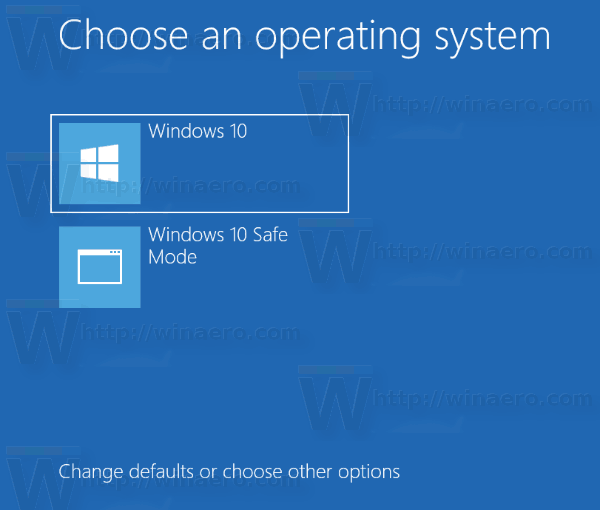In this post, we will take a look at the Windows Startup Settings, or Advanced Startup options Windows 10 and also see how to change Boot defaults when you are dual-booting your computer.
Oct 02, 2019 The Windows 10 Boot Loader does become the default when Windows 10 is installed. You can adjust this from within Windows 10 by going to Control Panel System Advanced System Settings. On the Advanced Tab, you have a Settings Button under Startup and Recovery. You can set your startup default operating system in there. Apr 20, 2017 For Windows, you can use BCDEdit to change the default boot entry. Using BCDEdit. You can specify the default boot entry using the /default option. The syntax to specify the default operating system is as follows: bcdedit /default The is the GUID for the Windows boot loader boot entry that is associated with. Jun 29, 2015 Change Windows 10 Boot default settings. You can click on Continue and exit to your default OS. You can use another installed operating system. You can troubleshoot your PC by opening Advanced Options. Or you can Turn Off your PC. Jul 03, 2018 Possible Boot Loader Corruption in Installation and Upgrade I have a Dual Boot Windows 10 Desktop (or did have) with one hard drive. The primary partition is Windows 10 - 1 (C) and the scondary partiton is Windows 10 - 2 (E). I booted normally this morning and ran disk cleaning and defrag software which.
When you dual-boot Windows 10 with an earlier version of Windows like Windows 8.1 or Windows, before you log in, you will see the following screen offering you the available operating systems. You can choose the operating system you wish to boot in, or by default, you will be booted you into default operating system after 10 seconds.
Windows 10 Boot Loader Menu
If you wish to change some of your default boot and login options and settings, you may click on the Change defaults or choose other options link, which you will see towards the bottom.
If you have only one OS installed, you may start your computer and then keep pressing the F8 key before Windows starts. You will see the Advanced Options screen.
Change Windows 10 Boot default settings
Once you do this, you will see the following Options screen. Here you can change the Timer settings, set the default operating system to boot into and set other options too.
Clicking on Change the timer will bring you to the following screen, where you can set the boot timer to 5 seconds, 30 seconds or 5 minutes. This is the time you have to wait before the default OS is automatically loaded. The default setting here is 10 seconds.
Clicking on Choose a default operating system will let you set the operating system you want to automatically load, after waiting for the set amount of time. The setting in my case is Windows 10.
Clicking on Choose an option will present you with the following options.
- You can click on Continue and exit to your default OS
- You can use another installed operating system
- you can troubleshoot your PC by opening Advanced Options
- Or you can Turn Off your PC.
Advanced Startup options Windows 10
If you need to troubleshoot problems with your Windows computer, you can click on Troubleshoot. When you do this, you are offered:
- Reset This PC option
- Advanced options.
If you wish to reset your PC, select Reset the PC option. If you need to access other troubleshooting and repair tools, click on Advanced Options, to arrive at the following screen.
Here you will see:
- System Restore: Useful if you want to restore your Windows 10 PC.
- System Image Recovery: Lets you recover your Windows using a system image file.
- Startup Repair: Fixes startup problems
- Command Prompt: Using the CMD you can access the more advanced built-in Windows tools
- Startup Settings: It lets you change Windows startup options
- Go back to the previous build.
If you wish to directly access these Advanced startup options when working on your Windows 10, you can do so via the Settings app of Windows 10 > Update & Security > Recovery > Advanced startup and click the Restart now button.
Clicking on Startup Settings will let you change the preset startup settings and options.

Here you can:
- Enable low-resolution mode
- Enable debugging mode
- Enable boot logging
- Enable Safe Mode
- Disable driver signature enforcement
- Disable early-launch anti-malware protection
- Disable automatic restart on system failure.
Windows 10 users may want to especially note that this is where you can enable Safe Mode.
Clicking on the Restart button will bring you to the following Startup Settings screen:
Boot Loader Manager Windows 10
You have to press the keys to bring up the options. Clicking on F10 will show you some more options including Launch recovery environment.
Pressing Enter will bring you back to your operating system.
These settings are useful to know as, not only can you change your boot defaults here, but they can also be very useful to you if your computer will not start or you need to troubleshoot and fix other Windows problems.
Related reads:
- Windows 10 fails to boot; Automatic Repair, Refresh, Reset PC also fails.
Change Boot Loader Windows 10 Reviews
Related Posts: